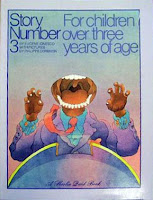 For whatever bizarre reason(s), I find myself reflecting on Eugene Ionesco's children's books today. Children's books, naturally, are a not-too-distant cousin of comics and it's not uncommon these days for celebrities to write a children's book for whatever reasons. (I suspect it has something to do with not "needing" to form complex plots or extensive characterization.) But back in the late 1960s and early 1970s, playwright Eugene Ionesco penned a series of children's books titled simply Story Number 1, Story Number 2, Story Number 3, and Story Number 4.
For whatever bizarre reason(s), I find myself reflecting on Eugene Ionesco's children's books today. Children's books, naturally, are a not-too-distant cousin of comics and it's not uncommon these days for celebrities to write a children's book for whatever reasons. (I suspect it has something to do with not "needing" to form complex plots or extensive characterization.) But back in the late 1960s and early 1970s, playwright Eugene Ionesco penned a series of children's books titled simply Story Number 1, Story Number 2, Story Number 3, and Story Number 4.Like many kids, I had any number of children's book as a child. Many classics like the works of Dr. Suess and various Little Golden books. My father was a fairly progressive parent at the time and also made a point of getting a number of books by Ezra Jack Keats and other other Caldecott and Newberry winners. But the Ionesco books stand out.
The basic premise of each book is that young Jaqueline is left in the care of an adult who tries to entertain her questions with extended on-the-spot stories. Each overly simplistic answer the child receives begs further questions which, to the storyteller, leads to increasingly bizarre twists and turns in an effort to keep the illusion of the original answer. For example, in one tale a housekeeper attempts to keep Jaqueline from disturbing her parents, who are sleeping off a hangover from the night before. But, rather than try to explain how and why the parents got drunk (and, for that matter, what "drunk" means) it evolves into an elaborate and complex story involving putting rainbows in your hair and climbing giant derby hats as if they were mountains. The stories have a stream-of-consciousness approach to them that wanders headlong into the surreal with each increasingly unlikely element of the story illustrated in exactly the way a child might imagine the situation.
 This is the type of thing I grew up on.
This is the type of thing I grew up on. A few years ago, my father tried cleaning out some of his old books and asked if there were any I wanted. Out of his entire library -- which is quite extensive for a personal collection -- I only asked for those four books and a hardcover Krazy Kat collection. Surreality to the n-th degree that represented my childhood.
To my knowledge, the Ionesco books have never been reprinted. Since they were written by a playwright who was by then very well-known for his absurdist performance pieces (what he called "anti-plays"), very little seems to have been written about these four short stories. Further, the titles themselves don't lend themselves to many productive Google searches!
So I'm curious how a man who did know how to think visually would develop a children's book to be illustrated by another person. How did he interpret and utilize the creative process in his illustrated works? How many notes did he give the artists? Certainly, he must have made SOME mention of the artwork -- otherwise the stories could easily be illustrated with, for example, a child sitting at the kitchen table listening.
I'll have to dig those books out again and see if I can divine anything from the art itself. I don't know that I've ever looked at it from a truely analytical point of view and it might be interesting to see what an objective (well... at least semi-objective) eye might see that the hungrier eyes of a child would've missed.






0 comments:
Post a Comment